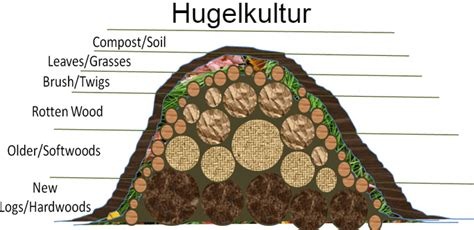Hügelkultur, a German term meaning "hill culture" or "mound culture," is a permaculture gardening technique that involves creating raised garden beds by piling logs, branches, and other organic materials, then covering them with soil. This method, rooted in traditional Eastern European practices, mimics natural forest processes to build fertile, low-maintenance beds that improve soil health, retain water, and boost plant growth. It’s particularly popular among sustainable gardeners for its efficiency and environmental benefits.
The method was popularized by Austrian farmer Sepp Holzer in the 1960s and 1970s, documented in books such as Sepp Holzer’s Permaculture. He built on centuries-old practices where farmers used decaying wood and organic matter to create fertile raised beds. The technique gained broader attention through permaculture advocates like Paul Wheaton and Bill Mollison, who spread Holzer’s methods globally. Their books are available on Amazon and other retailers, and you can find hügelkultur videos on YouTube.
The process begins with selecting a site, typically 4–6 feet wide and any length, depending on space. A shallow trench is dug, and large logs or woody debris, preferably from hardwood trees like oak or maple, are layered at the base. These form the core of the mound, providing structure and long-term nutrient release. Smaller branches, twigs, and organic matter like grass clippings, leaves, or straw are added next, followed by compost or manure to enhance microbial activity. The pile is capped with topsoil, forming a mound 2–6 feet tall, often shaped like a steep triangle or trapezoid to maximize surface area. Although the bed can be planted immediately, many gardeners let it settle for a season.
As the wood decomposes, it acts like a sponge, retaining moisture and reducing the need for frequent watering, ideal for arid climates or drought-prone areas like the one we live in. Decomposition also generates heat, extending the growing season in cooler regions by warming the soil. Over time, the breaking down of organic matter releases nutrients, creating a rich, fertile environment that supports diverse crops, from vegetables to perennials. The process can take years, with larger logs providing benefits for up to a decade, making hügelkultur a long-term investment in soil health and reducing the need for chemical fertilizers.
A similar technique can be used here in the desert where a much deeper trench or circular pit is dug out, then layered so that your tree or shrub is ground level when planted, or is in a shorter mound. This helps provide moisture retention in the local sandy soil while also providing long term nutrients. The concept can also apply to enclosed raised beds.
Plan ahead. If you intend to plant trees next fall then start digging your pits way ahead of time, preferably right after winter and spring rains, when the ground is not like hard cement. So when a storm passes grab a shovel and start digging. Once complete, you can spend the next several months layering your mound in preparation for next fall’s tree planting, and next summer’s heat will speed the breakdown of nutrients and growth of beneficial microbes.
The technique offers multiple benefits. It recycles yard waste, reducing landfill use and the need for synthetic fertilizers. A raised structure improves drainage, prevents root rot in wet climates, and makes gardening more accessible by reducing bending. Additionally, the method supports biodiversity by fostering microbial life and attracting beneficial insects. However, there are challenges. Building a hügelkultur bed requires significant up-front labor and access to woody materials. Freshly cut "green" wood can temporarily deplete soil nitrogen as it decomposes, so seasoned or partially rotted wood like those dead creosote branches that are everywhere is preferred.
Hügelkultur is versatile, adaptable to various climates and scales, from small backyard gardens to large farms. It’s especially effective for gardeners aiming to create self-sustaining ecosystems with minimal inputs. By harnessing natural decomposition, hügelkultur transforms waste into a productive resource, embodying permaculture’s ethos of working with nature.

